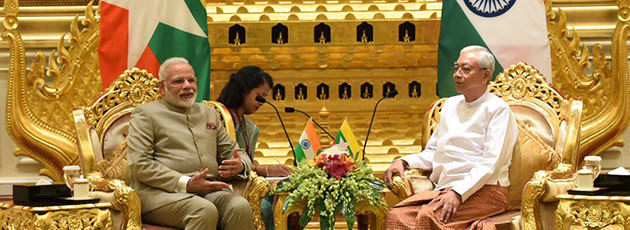India has a deepening bilateral security relationship with Myanmar, and is taking steps to help address the crisis in Rakhine State. But Chinese influence in Myanmar is growing – and meaningful cooperation between Beiijing and New Delhi remains unlikely.
India’s relationship with Myanmar – the only Association of Southeast Asian Nations (ASEAN) country with which it shares a land border – is a significant foreign policy priority for the government of Narendra Modi.
New Delhi views the nation as a key part of its ‘Act East’ policy, which was announced by Modi during the 12th ASEAN–India Summit in Myanmar in 2014. India believes it can use Myanmar to strengthen trade links and increase engagement with the regional grouping – but sees Myanmar as a neighbour first, and an ASEAN member second.
The two countries have enjoyed growing bilateral high-level engagement recently, most notably when Modi visited Myanmar in September 2017, only the second bilateral prime ministerial visit by India to the country in 30 years. India’s foreign minister, deputy national security adviser and foreign secretary have all separately visited Myanmar in the last six months. State Counsellor of Myanmar Aung San Suu Kyi visited New Delhi in January 2018, one of ten ASEAN leaders who were the chief guests at India’s 2018 Republic Day parade.
Bilateral security relations
India’s foreign ministry has separate divisions for ‘Bangladesh and Myanmar’ and ASEAN, which means the country’s diplomats deal with matters relating to its relations with Myanmar as a neighbour separately to those relating to Myanmar as an ASEAN state.
Security and defence relations between the two countries focus primarily on border security and counter-terrorism. The first-ever India–Myanmar Bilateral Military Exercise (IMBAX-2017), took place over six days in November 2017, and focused on peacekeeping operations. India’s concerns over border security were emphasised in a June 2015 ‘surgical strike’ in Myanmar by the Indian army’s special forces unit, which killed at least 60 insurgents from the Myanmar-based Khaplang faction of the National Socialist Council of Nagaland (NSCN-K), in response to the killing of 18 Indian soldiers by the NSCN-K.
India also plays a role in Myanmar’s own internal peace process, acting as a signatory witness to Myanmar’s Nationwide Ceasefire Agreement ceremonies in February 2018 and October 2015. India hosted Myanmar’s top general for a week-long visit last July, during which he met Prime Minister Modi. India’s defence minister witnessed operations along the India-Myanmar border on 29 May.
Maritime cooperation between the two countries has also gained importance, with the Indian and Myanmar navies conducting their first-ever bilateral naval exercise, IMNEX-18, in March in the Bay of Bengal. The Myanmar navy also participated in the biennial, multilateral Milan naval exercise off the coast of the Andaman and Nicobar Islands in early March.
In 2017, the two countries signed an agreement to enhance maritime security cooperation in areas such as humanitarian assistance. India is also developing Sittwe port in Myanmar’s Rakhine State and implementing the US$484m Kaladan transport project, which will connect Rakhine State with India’s northeastern state of Mizoram.
Economic relations have an ASEAN-wide focus
In sharp contrast to these bilateral security and defence relations, India’s major economic and connectivity projects with Myanmar have an ASEAN-wide scope. India, Myanmar and Thailand are jointly developing a 1,360km highway – to be operational by December 2019 – designed to link the three countries and improve connectivity between India and ASEAN states. The highway may eventually be extended to connect India with Vietnam through Cambodia and Laos. India is also undertaking a US$77m rural connectivity project to provide basic internet access to villages in Myanmar, Vietnam, Cambodia and Laos, a scheme that could be replicated in other ASEAN countries.
India’s connectivity projects with Myanmar also include the Bangladesh–China–India–Myanmar (BCIM) Economic Corridor, currently under joint study. India and China agreed to ‘speed up’ economic cooperation in the BCIM corridor during April’s informal summit between Modi and China’s President Xi in Wuhan.
However, questions remain over whether the corridor will be implemented, with China insisting that it be a ‘key channel’ of its Belt and Road Initiative (BRI), and India emphasising that the BCIM predates the BRI. The BCIM corridor has not been mentioned in any Indian foreign ministry statement – not even in its account of the Modi–Xi summit – since June 2017, shortly after India declined to attend China’s BRI summit.
India attempts to balance Myanmar and Bangladesh over Rohingya crisis
India aims to balance relations between two of its neighbours, majority Buddhist Myanmar and Muslim Bangladesh, which are strained by the fate of Rohingya Muslims in Myanmar’s Rakhine State. Since August 2017 nearly 700,000 Rohingya Muslims – an ethnic category that is not recognised by the Myanmar government – have fled the Myanmar armed forces’ brutal military operations, causing a major humanitarian crisis in neighbouring Bangladesh. India views the Rohingya crisis from both a humanitarian and security perspective. Modi has said that India shares Myanmar’s concern of ‘extremist violence’ in Rakhine State.
India – which talks of ‘displaced persons from Rakhine State’ in official statements, due to Myanmar’s sensitivities over the term Rohingya – underlined the need for the ‘safe, speedy and sustainable’ return of the Rohingya refugees during the Indian foreign minister’s visit to Myanmar in mid-May. In December, India committed US$25m of development assistance, to be transferred over five years, to help the ‘restoration of normalcy’ in Rakhine State, and the return of the Rohingya refugees to Myanmar. This followed the signing of an agreement between India and Myanmar for a development programme in Rakhine State. India is currently building pre-fabricated housing for refugees returning there.
India’s engagement with Bangladesh over the crisis has included two meetings between Modi and Prime Minister of Bangladesh Sheikh Hasina since October 2017, and visits to Bangladesh by India’s foreign minister and foreign secretary. India has also provided relief materials for refugees in Bangladesh including food and mosquito nets.
China’s increased engagement
The crisis in Rakhine State takes place at a time of growing Chinese investment in both Myanmar and Bangladesh. Its engineers are developing a 13km flood-defence embankment in the Bay of Bengal, as a temporary arrangement to ease the pressure on refugee camps in the Bangladesh city of Cox’s Bazaar.
Following a visit to both Bangladesh and Myanmar in November 2017, China’s foreign minister outlined a three-phase proposal to address the crisis: firstly, a ceasefire should be implemented in Rakhine State; secondly, Bangladesh and Myanmar should be encouraged to strengthen communication; and finally, the region should be developed economically. In September, to help ‘restore peace and stability’, Beijing donated US$150,262 to assist the development of Rakhine State. China is Myanmar’s largest trading partner and supports its position on the Rohingya crisis, and alongside Russia has shielded Myanmar from strong action by the UN Security Council.
A Chinese state-owned firm also has a 70% stake in the building of a US$7.3bn deep-sea port and US$2.7bn special economic zone in Rakhine State as part of the BRI. This port project will provide an entry point for a US$1.5bn oil and gas pipeline between Kyaukpyu and Kunming in China’s Yunnan Province. China and Myanmar have also agreed to develop an economic corridor between Kunming and Kyaukpyu, also as part of the BRI. Across the border, China has agreed to provide Bangladesh with US$22bn of assistance until 2024.
Can India and China work together to help resolve the Rohingya crisis?
India’s attempts to balance relations between Myanmar and Bangladesh amid growing Chinese influence in both countries is a key challenge for its ‘neighbourhood first’ policy. Both India and China will have a keen interest in a special session at the IISS Shangri-La Dialogue, Asia’s premier security summit, titled ‘The Security and Humanitarian Crisis in Myanmar’s Rakhine State’. Senior officials from Myanmar and Bangladesh will join the President of the International Committee of the Red Cross and an official from the European Union External Action Service to discuss how to resolve the crisis.
India and China both pledged closer cooperation following their informal summit in Wuhan earlier this year. The likely prospect is that India and China will pursue their separate approaches to the security and humanitarian situation in Rakhine State. These may bear similarities and could possibly lead to narrow convergences – as highlighted through their recent informal summit. However, it is unlikely that such convergences will outweigh the overall uneasiness between India and China.
Date: 31 May 2018
Viraj Solanki, Research Analyst, South Asia Programme













































